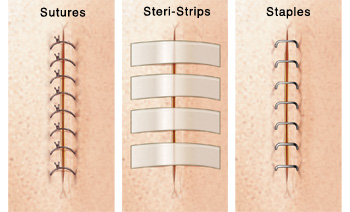Incision Care
Incision Care
Remember: Follow-up visits allow your healthcare provider to make sure your incision is healing well. Be sure to keep your appointments.

Home care
Tips for home care include the following:
Always wash your hands before and after touching your incision.
Keep your incision clean and dry.
Avoid doing things that could cause dirt or sweat to get on your incision.
Don’t pick at scabs. They help protect the wound.
Keep your incision out of water.
Take a sponge bath to avoid getting your incision wet, unless your healthcare provider tells you otherwise.
Ask your provider when can you take a shower or bathe.
Ask your provider about the best way to keep your incision dry when bathing or showering.
Pat stitches dry if they get wet. Don’t rub.
Leave the bandage (dressing) in place until you are told to remove it or change it. Change it only as directed, using clean hands.
After the first 12 hours, change your dressing every 24 hours, or as directed by your healthcare provider.
Change your dressing if it gets wet or soiled.
Care for specific closures
Follow these guidelines unless your healthcare provider tells you otherwise:
Stitches or staples. Once you no longer need to keep these dry, clean the wound daily. First remove the bandage using clean hands. Then wash the area gently with soap and warm water. Use a wet cotton swab to loosen and remove any blood or crust that forms. After cleaning, put a thin layer of antibiotic ointment on. Then put on a new bandage.
Skin glue. Don’t put liquid, ointment, or cream on your wound while the glue is in place. Avoid activities that cause heavy sweating. Protect the wound from sunlight. Do not scratch, rub, or pick at the glue. Do not put tape directly over the glue. The glue should peel off within 5 to 10 days.
Surgical tape. Keep the area dry. If it gets wet, blot the area dry with a clean towel. Surgical tape usually falls off within 7 to 10 days. If it has not fallen off after 10 days, contact your healthcare provider before taking it off yourself. If you are told to remove the tape, put mineral oil or petroleum jelly on a cotton ball. Gently rub the tape until it is removed.
Changing your dressing
Leave the dressing (bandage) in place until you are told to remove it or change it. Follow the instructions below unless told otherwise by your healthcare provider:
Always wash your hands before changing your dressing.
After the first 48 hours, the incision wound usually will have closed. At this point, leave the incision uncovered and open to the air. If the incision has not closed keep it covered.
Cover your incision only if your clothing is rubbing it or causing irritation.
Change your dressing if it gets wet or soiled.
Follow-up care
Follow up with your healthcare provider to ask how long sutures or staples should be left in place. Be sure to return for stitch or staple removal as directed. If dissolving stitches were used in your mouth, these will not need to be removed. They should fall out or dissolve on their own.
If tape closures were used, remove them yourself when your provider recommends if they have not fallen off on their own. If skin glue was used, the glue will wear off by itself.
When to seek medical care
Call your healthcare provider if you have any of the following:
More pain, redness, swelling, bleeding, or foul-smelling discharge around the incision area
Fever of 100.4°F (38ºC) or higher, or as directed by your healthcare provider
Shaking chills
Vomiting or nausea that doesn't go away
Numbness, coldness, or tingling around the incision area, or changes in skin color
Opening of the sutures or wound
Stitches or staples come apart or fall out or surgical tape falls off before 7 days or as directed by your healthcare provider
Updated:
April 26, 2018
Sources:
Changing Surgical Dressings. Nattina S. Lippincott Manual of Nursing Practice. 2010;9:128., Closure of minor skin wounds with staples. UpToDate., Closure of skin wounds with sutures. UpToDate., Guideline for Prevention of Surgical Site Infection. Mangram A. Infection Control and Hospital Epidemiology. 1999;20(4):247-78., Minor wound repair with tissue adhesives (cyanoacrylates). UpToDate.
Reviewed By:
Image reviewed by StayWell medical illustration team.,Sudheendra, Deepak, MD,Taylor, Wanda L, RN, Ph.D.